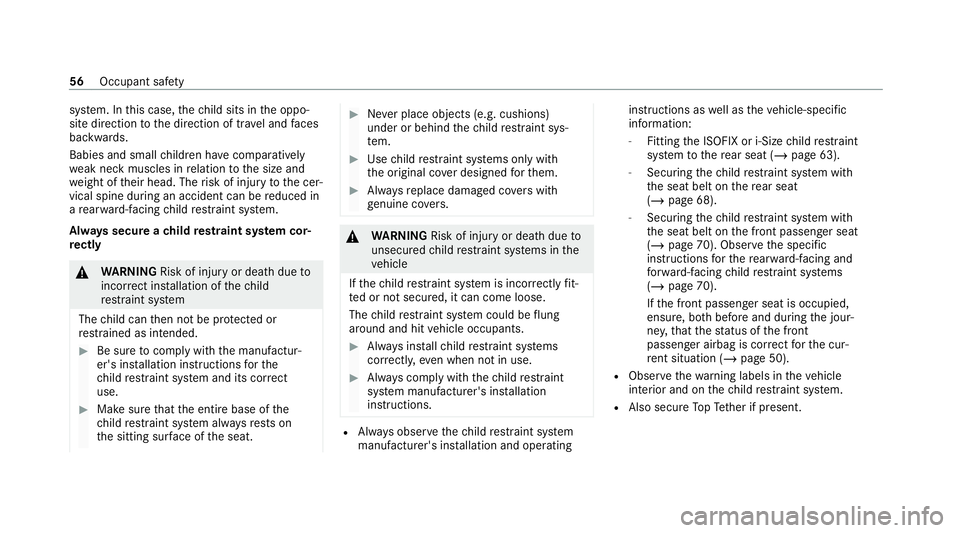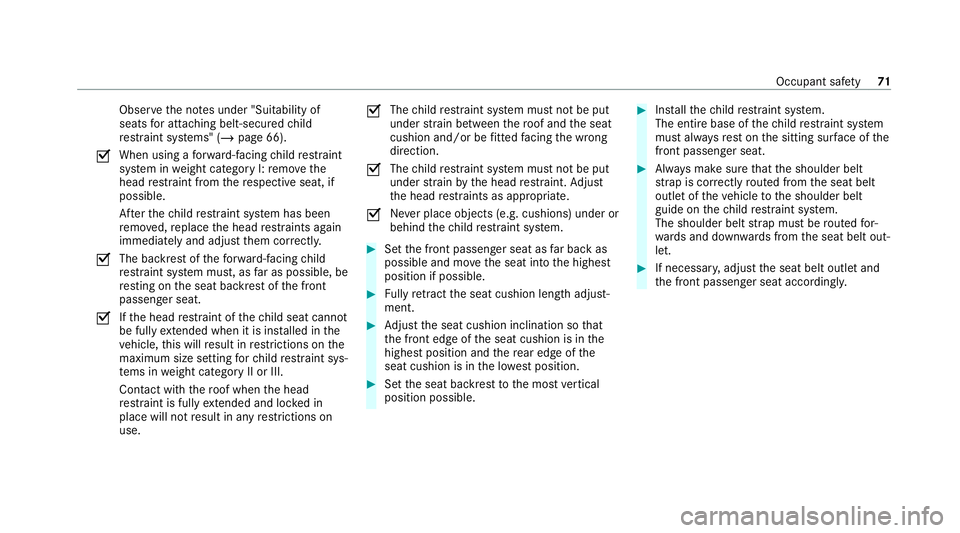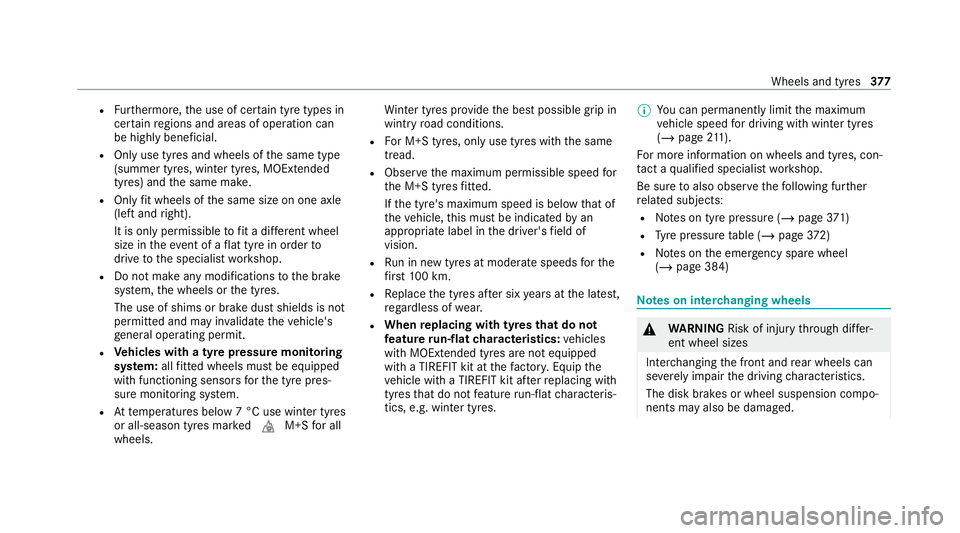2021 MERCEDES-BENZ GLE COUPE tire size
[x] Cancel search: tire sizePage 59 of 525

sy
stem. In this case, thech ild sits in the oppo‐
site direction tothe direction of tra vel and faces
ba ckwa rds.
Babies and small children ha vecompa ratively
we ak neck muscles in relation tothe size and
we ight of their head. The risk of injury tothe cer‐
vical spine during an accident can be reduced in
a re ar wa rd-facing child restra int sy stem.
Alw ays secure a child restra int sy stem cor‐
re ctly &
WARNING Risk of injury or death dueto
incor rect ins tallation of thech ild
re stra int sy stem
The child can then not be pr otected or
re stra ined as intended. #
Be sure tocomply wi th the manufactur‐
er's ins tallation instructions forthe
ch ild restra int sy stem and its cor rect
use. #
Makesure that the entire base of the
ch ild restra int sy stem alw aysre sts on
th e sitting sur face of the seat. #
Never place objects (e.g. cushions)
under or behind thech ild restra int sys‐
te m. #
Use child restra int sy stems only with
th e original co ver designed forth em. #
Alw aysre place damaged co vers with
ge nuine co vers. &
WARNING Risk of injury or death dueto
unsecured child restra int sy stems in the
ve hicle
If th ech ild restra int sy stem is incor rectly fit‐
te d or not secured, it can come loose.
The child restra int sy stem could be flung
around and hit vehicle occupants. #
Alw ays ins tallch ild restra int sy stems
cor rectl y,eve n when not in use. #
Alw ays comply with thech ild restra int
sy stem manufacturer's ins tallation
instructions. R
Alw ays obser vethech ild restra int sy stem
manufacturer's ins tallation and operating instructions as
well as theve hicle-specific
information:
- Fitting the ISOFIX or i-Size child restra int
sy stem tothere ar seat (/ page 63).
- Securing thech ild restra int sy stem with
th e seat belt on there ar seat
(/ page 68).
- Securing thech ild restra int sy stem with
th e seat belt on the front passenger seat
(/ page 70). Obser vethe specific
instructions forth ere ar wa rd-facing and
fo rw ard-facing child restra int sy stems
(/ page 70).
If th e front passenger seat is occupied,
ensure, bo thbefore and during the jour‐
ne y,that thest atus of the front
passenger airbag is cor rect forth e cur‐
re nt situation (/ page 50).
R Obse rveth ewa rning labels in theve hicle
interior and on thech ild restra int sy stem.
R Also secure TopTe ther if present. 56
Occupant saf ety
Page 74 of 525

Obser
vethe no tes under "Suitability of
seats for attaching belt-secu redch ild
re stra int sy stems" (/ page 66).
0073 When using a
forw ard-facing child restra int
sy stem in weight category I: remo vethe
head restra int from there spective seat, if
possible.
Af terth ech ild restra int sy stem has been
re mo ved, replace the head restra ints again
immediately and adjust them cor rectly.
0073 The ba
ckrest of thefo rw ard-facing child
re stra int sy stem must, as far as possible, be
re sting on the seat backrest of the front
passenger seat.
0073 If
th e head restra int of thech ild seat cannot
be fully extended when it is ins talled in the
ve hicle, this will result in restrictions on the
maximum size setting forch ild restra int sys‐
te ms in weight category II or III.
Contact with thero of when the head
re stra int is fully extended and lo cked in
place will not result in any restrictions on
use. 0073
The
child restra int sy stem must not be put
under stra in between thero of and the seat
cushion and/or be fitted facing the wrong
direction.
0073 The
child restra int sy stem must not be put
under stra in by the head restra int. Adjust
th e head restra ints as appropriate.
0073 Ne
ver place objects (e.g. cushions) under or
behind thech ild restra int sy stem. #
Set the front passenger seat as far back as
possible and mo vethe seat into the highest
position if possible. #
Fully retract the seat cushion length adjust‐
ment. #
Adjust the seat cushion inclination so that
th e front edge of the seat cushion is in the
highest position and there ar edge of the
seat cushion is in the lo west position. #
Set the seat backrest tothe most vertical
position possible. #
Installth ech ild restra int sy stem.
The entire base of thech ild restra int sy stem
must alw aysre st on the sitting sur face of the
front passenger seat. #
Alw ays make sure that the shoulder belt
st ra p is cor rectly routed from the seat belt
outlet of theve hicle tothe shoulder belt
guide on thech ild restra int sy stem.
The shoulder belt stra p must be routed for‐
wa rds and down wards from the seat belt out‐
let. #
If necessar y,adjust the seat belt outlet and
th e front passenger seat according ly. Occupant saf
ety71
Page 380 of 525

R
Furthermore, the use of cer tain tyre types in
cer tain regions and areas of operation can
be highly beneficial.
R Only use tyres and wheels of the same type
(summer tyres, winter tyres, MOEx tended
tyres) and the same make.
R Only fit wheels of the same size on one axle
(left and right).
It is only permissible tofit a di fferent wheel
size in theeve nt of a flat tyre in order to
drive tothe specialist workshop.
R Do not make any modifications tothe brake
sy stem, the wheels or the tyres.
The use of shims or brake dust shields is not
permitted and may in validate theve hicle's
ge neral operating pe rmit.
R Vehicles with a tyre pressure monitoring
sy stem: allfitted wheels mu stbe equipped
with functioning sensors forth e tyre pres‐
sure monitoring sy stem.
R Attemp eratures below 7 °C use winter tyres
or all-season tyres mar ked004D M+Sfor all
wheels. Wi
nter tyres pr ovide the best possible grip in
wintry road conditions.
R For M+S tyres, only use tyres with the same
tread.
R Obser vethe maximum permissible speed for
th e M+S tyres fitted.
If th e tyre's maximum speed is below that of
th eve hicle, this must be indicated byan
appropriate label in the driver's field of
vision.
R Run in new tyres at moderate speeds forthe
fi rs t10 0 km.
R Replace the tyres af ter six years at the latest,
re ga rdless of wear.
R When replacing with tyres that do not
fe ature run-flat characteristics: vehicles
with MOExtended tyres are not equipped
with a TIREFIT kit at thefa ctor y.Equip the
ve hicle with a TIREFIT kit af terre placing with
tyres that do not feature run-flat characteris‐
tics, e.g. winter tyres. %
You can permanently limit the maximum
ve hicle speed for driving with winter tyres
(/ page 211).
Fo r more information on wheels and tyres, con‐
ta ct a qualified specialist workshop.
Be sure toalso obse rveth efo llowing fur ther
re lated subjects:
R Notes on tyre pressure (/ page371)
R Tyre pressure table (/ page372)
R Notes on the emer gency spa rewheel
(/ page 384) Note
s on inter changing wheels &
WARNING Risk of injury thro ugh dif fer‐
ent wheel sizes
Inter changing the front and rear wheels can
se verely impair the driving characteristics.
The disk brakes or wheel suspension compo‐
nents may also be damaged. Wheels and tyres
377